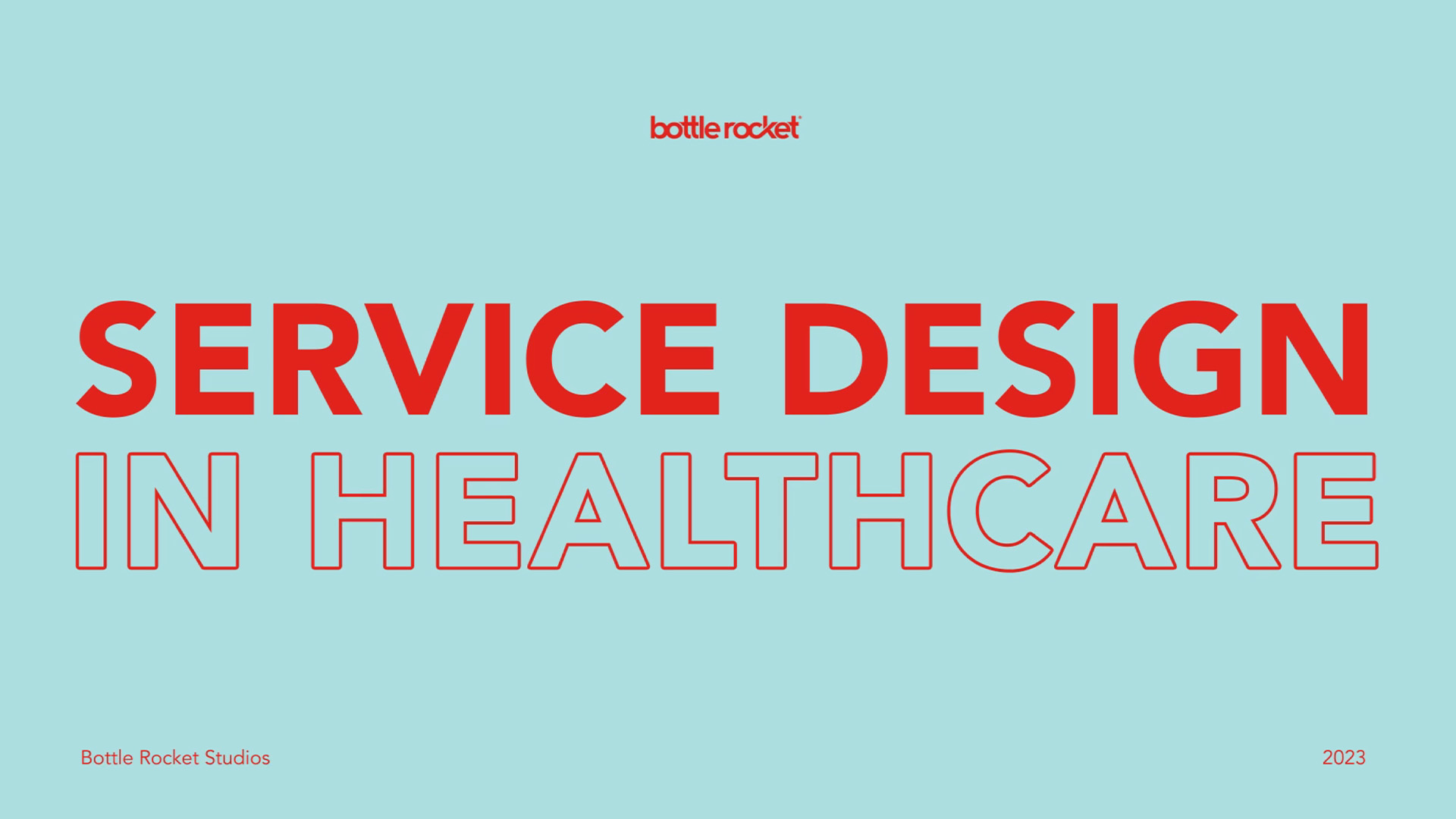Published by
Have burning healthcare questions? We’ve got the experts for answers. Join the healthcare and strategy pros as they team up to tackle industry challenges head-on. Listen in as they uncover pain points and solutions with firsthand experience. Watch the video or read the transcript below:
Ashley Banegas
Today we’re talking about service design in healthcare. My name is Ashley. I’m an Experience Consultant here at Bottle Rocket and our resident service design expert. I’m joined by our healthcare program manager Matt Tobias. And today we’re talking through some of the most common questions that we hear from our healthcare clients. Before we get into it, though, why are we talking about this today? Why service design? Service design is uniquely positioned to wrangle big, complex ecosystems and in a world of healthcare, there’s tons of digital and physical touch points that come together to make up that complete patient journey. Within that journey, there’s tons of systems and tools and care providers processes and regulations, and in the time period since COVID, for example, the amount of digital solutions integrated into these systems has skyrocketed. So service design is really critical and making sure that these technologies actually increase the quality of care for patients and the efficiency and productivity of the system. It can, first of all, help identify problems in the system, break down silos between departments and then create that intentional, highly connected experience that makes patients feel cared for the whole way through.
Matt Tobias
In healthcare, we have this reputation that change is slow and hard. I think that’s a byproduct of healthcare naturally being risk averse. When your whole ethos is based on first “do no harm, that deliberate, thoughtful, and deliberate change baked into the culture. With all the pressures that we have consumerism. Other players like Amazon and Walmart, taking a chunk of the primary care market and a shift to value-based care. Change at a previously unseen speed is necessary for survival. service design can bring that balance between that need for rapid change and a thoughtful, deliberate approach. Let’s get to it.
Communication between patients and providers can be clunky and overwhelming. How might we fix that?
Ashley Banegas
So I think this touches on the concept of omni-channel healthcare, meaning that someone’s journey can come in a bunch of different forms. Communication between patients and providers can happen in a number of different ways. An in-person appointment followed by a message in the portal, a telehealth appointment that’s followed up by an email. And nowadays we’re even doing remote monitoring with some sort of wearable that’s, you know, giving information passively to your care provider. There’s so many new technologies aimed at closing this gap between patients and providers. Service design gives us the tools to look at these technologies and helps us create some intentionality around how they actually inform care. Are they aligned with patient preferences? Like the way the patient prefers to communicate, what tools they’re already using, and how to connect with all the other parts of the patient journey. Messaging is a hugely critical moment in a patient’s journey. For instance, a clunky hard-to-use portal could actually be where someone is going anxiously awaiting their test results. You don’t want to leave those moments up to chance. You really want to look at messaging and communication as a key component of the patient journey, because it’s threaded throughout every milestone of their care.
Matt Tobias
Let me just say, everyone, we talked to struggles with this portal messaging is the hot topic right now, because it’s a real case of the dog has caught the car and doesn’t know what to do with it. We’ve implemented this new touch point and people are using it and we’re like, “okay, what do we do with all this information?” It’s not the first time that we’ve implemented a technological solution and clinicians or operational staff aren’t necessarily ready to keep up with enthusiastic response. As you say, Ashley, the key here is not to confuse the medium that portal messaging, in this case, with the actual problem of “we’re receiving too many requests for care, requests for things that we as clinicians don’t have bandwidth to cover.” So let’s take a step back. Are we routing these messages to the right people? Not every message is created equal. Are we getting clinical messages to physicians? Are we getting scheduling messages to schedulers? How might we make it easy for the patient to choose the right path, so you get the right message to the right person? If I’m just looking to schedule an appointment, I don’t need to make a message to my provider. I can be guided towards the cell service scheduling option. No messages need to be created in the first place. And then we have fewer messages to deal with.
Ashley Banegas
Once a patient books an appointment how do we help them fill out the forms ahead of time for a smoother check-in process?
Matt Tobias
When I tell people that I work in healthcare, this is the scenario that comes up every time. Stand-ups have bits about this because it’s so ubiquitous, every one of these forms and these pieces of information that we’re filling out are super important to somebody and they might be going into different systems. What we’re finding, just like anything else in humanity, we build up these things over time and it gets to the point where it does reach a point of unsustainability. So how might we if we already have an answer in our system to something pre-populate that form for somebody or have these assessments talk to each other? Are we even asking the right questions anymore? The question that we needed to ask 10 years ago, is that even still relevant to it? Is anybody actually doing anything with this information going forward? Is the totality of the experience that’s overwhelming. Not any one part of it.
Ashley Banegas
Yeah, I totally agree. From the design side of things, I think the key to this part of the patient journey is making sure that the human factor isn’t lost. The seemingly insignificant part of the patient journey, but honestly, paperwork is kind of a big deal. Like you mentioned, the providers want to make sure that everything’s filled out accurately and, nothing important is missed. It’s being routed to insurance, billing, wherever it needs to go. But paperwork is kind of a big deal for patients too, it can be stressful to fill out. It takes a long time to make sure that all the fields are filled out accurately. And you can imagine that if a patient shows up to an appointment, and they’re asked to do it all over again, they’re disappointed, they have this impression that their provider doesn’t care, and they don’t have their act together. “Why did you have me do all this paperwork in the first place?” I think it breaks trust early on with patients when something as basic as paperwork, feels disjointed and completely overlooked.
Matt Tobias
When a patient is discharged from our hospital. How do we ensure that care continues and is coordinated even if it’s outside our own system?
Ashley Banegas
So this is where the idea of holistic, connected care for patients comes into play. And holistic is really kind of the word of the day here. It’s not enough to just understand how all the different phases of patient care are strung together. It’s important to actually design what that looks like to design the handoffs end-to-end. Continuity, especially between systems can be a huge challenge. And this challenge isn’t really solved by just adding in a bunch more digital elements along the way to kind of band-aid over the coordination. Actual coordination requires getting full entities to work together – people, systems, and processes, and to actually define how everything connects. You’ll probably need to adjust things behind the scenes to make that experience better for patients, not just shoehorning in processes here and there that don’t fit the whole system. The experience blueprint is a really great tool for this because, in essence, it maps out how everything comes together and delivers that whole patient experience. So you can visually see where the biggest problems are. Where some of the handoffs have the biggest friction, which ones are broken, which systems don’t talk to each other– is an activity that provides a lot of value when the conversation is about connections and continuity.
Matt Tobias
This one’s a doozy. Speaking of broken handoffs, I remember when transitions of care were first implemented as part of Meaningful Use. We were discharging patients and sending these 70-page faxes over to primary care providers that were for their follow-up. There’s these well-intentioned fixes, in this case from the United States government, that were being put on us that because they weren’t properly thought through, really ended up backfiring. If we’re going to move to a value-based care system in this country, and we have multiple providers and even multiple payers involved in the care of a particular patient. We have no choice but to work together. So let’s use the service design tools and these other great tools to make these things happen.
Ashley Banegas
How might we ensure we welcome patients into our system when we acquire a practice?
Matt Tobias
Anyone that’s been in healthcare for more than a few years has felt the pain of mergers and acquisitions, you know, bringing together different cultures processes, and egos is daunting. But aside from that, now we’re hearing from patients that you know, “we’re being left out of this process.” I might get a you know, a letter in the mail that says like “Only the sign on the side of the building is changing,” but that’s not the reality. There is a whole new set of processes from the
patient’s point of view that have to have to be happening. The patient that has been acquired needs that same glide path into the system that a net new patient has and how we’re going to make these different systems work together is where service design can come in. Ashley, I know you have some experience in this area.
Ashley Banegas
Yeah, so recently, my mortgage provider changed and I didn’t have much communication about it. All of a sudden, I had to set up a new username, password, profile, and I had to do it within a short period of time before my next payment was due and honestly I felt really powerless. So you can imagine that a patient, who has had a relationship with a care provider feels this exponentially. Having to detach themselves not from just like their logins and passwords, but actually their relationship with their provider or their relationship with the system. But chances are that the folks actually in charge of handling this, like Yours, Mine and Ours of systems and patients in a merger kind of feel helpless too. So it’s a big challenge. One benefit of service design and one that really lives kind of under the radar is its ability to help and change management. Having this big-picture view of all the tools being used, for what capabilities and how it impacts the patient journey can be a really valuable point of view to have as you make decisions about what stays, and what goes. And again back to that word intentional how you can intentionally design the transition between the two so that the patients are put back in the process.
Matt Tobias
With all the patient talks that we have what about clinicians? How do we coordinate consulting clinicians and support staff, with something like a chaplain when they’re not using the same software?
Ashley Banegas
I love this question because I think human-centered design a lot of times we think is really just a luxury for the person who’s on the receiving end of that product or service. So a customer, a guest, a patient. However the providers are people too, the clinicians and support staff are also worthy of this human centered this. Service design as a practice reminds us to care a lot about all these other roles in the ecosystem. So we want to extend that care, that intentionality that, human centeredness to doctors, nurses, clinicians, just the same as we do patients. Without providers, the patient experience breaks down. So we want to make sure that the tools and processes that they’re operating with can actually support and not hinder their work. An example that I see really often is that leadership decides to change or upgrade a tool, you know, for the betterment of the system, but then it’s just kind of handed down to clinicians without really understanding what the impacts are. I know that this happened a lot during COVID when everybody was working really quickly to find digital solutions for some of their problems. But it’s handed down to the teams without understanding how it will actually change processes, how it will affect day-to-day, how people will actually find time to do the training, or how training will be weaved into an already busy workflow, a healthcare system that’s connected where the providers are also cared for and communication leads to efficiency and productivity. And obviously, this makes it a good place to work. So it’s a win-win for everybody.
Matt Tobias
I suspect this question was near and dear to somebody’s heart. Clinicians and staff, they have their own journeys that they’re going through. They have their own multiple systems, multiple touch points, that they have to work with and make sure that they’re working together to get to the ultimate good outcome that we’re looking for. Looking through their lens can not only help their make their lives better, it’s going to reduce their burnout which is ultimately, even can be good for the patient and long run getting back to the patient again. When a provider or nurse finds out that a patient needs services somebody like to chat, like we talked about in the initial question, how that goes about, I’ve seen that answer differently everywhere I’ve ever been. Some people might pick up a phone and make a phone call. Some people or provider might go into the EHR and put in an order or nurse might go into the EHR and enter a value in a float value row that might trigger something within the EHR to send a message to the chaplain, but what did the chaplain doesn’t spend their whole day for in EHR, they have other things that they do. I’ve seen people send push notifications to mobile devices that are handed off from different chaplains ship to ship. I have seen pagers go off in the 21st century. I have seen printouts spit out on a piece of paper, on a printer that one you hope is working, and then two you hope somebody walks by and picks up and actually does something with that. There’s all these janky workarounds that are put into place by the people, by necessity, when they don’t have that thoughtful design behind it to make these things work. Working around these janky workarounds with service design, we can actually take this to a more efficient route. And we can make things better for everybody along the way in this path.




